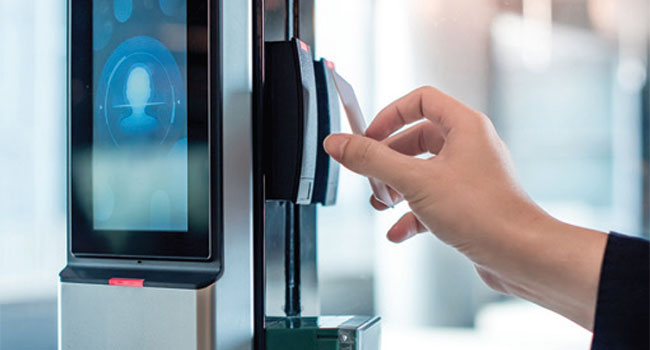
Improving Entrances with AI
Because security entrances do not have AI built into their technology, integrating intelligence into secured entrances requires a collaborative effort
- By Kurt Measom
- Dec 02, 2020
With the evolving dynamics
of cloud storage and
the ability to harness
and proactively employ
an ever-increasing pool of big data, AI
in the form of machine learning and deep
learning has become a disruptive technological
force in the physical security industry.
Advanced AI and low-cost network
resources have significantly impacted video
surveillance, which has been among the
biggest beneficiaries of faster processing
and impactful analytics. Building automation,
fire systems, intrusion detection, and
physical and network access control are all
starting to incorporate AI functionality.
Finding the Right Balance
with an AI Integration
But can AI play a role in making exterior
and interior entrances more secure?
Can AI improve system functionalities,
including: distinguishing people from
objects at a facility perimeter and interior
entrances; deter piggybacking; spot
and analyze potentially lethal objects and
dangerous people; and help define secure
areas in and around buildings creating a
more defensive risk posture for an organization?
As we move to greater converged technology
at the edges of connected systems,
we face the challenge of how AI may
practically support entry solutions such
as security revolving doors, turnstiles, and
swing doors. A disconnect between the objectives
of the building owner and building
code regulations can further complicate
the security blueprint.
Consultant Ben Butchko, president
and CEO of Butchko, Inc. and a former
security engineer with ExxonMobil, warns
that manufacturers’ goals must align with
their end users’ needs when it comes to
driving the development of embedded solutions with advanced sensors (cameras,
microwave, LIDAR), operational analytics
(facial recognition, tracking, object
discrimination, pattern recognition), and
active response (entry lockout, alert noti-
fication) that can be implemented now to
prevent or deter unauthorized entry.
“The security entrance must be part
of the general building operations design,
clearly separated from an architect’s complete
authority. Most secured entries are
specified in CSI Division 28, outside of
building design since it is structural and
falls under code compliance surrounding
emergency egress as well as building capacity
and throughput. Therefore, if this is
to work, the rules for design and the merging
of Division 28 and Division 8 must become refined, practical, and widely accepted,”
Butchko said.
Because security entrances do not have
AI built into their technology, integrating
intelligence into secured entrances
requires a collaborative effort with a thirdparty
solutions provider. Video analytics
are increasingly deployed to address use
cases such as people detection, piggybacking,
dangerous object detection and facial
recognition among other issues relevant
to secured entrances. The increased integration
of AI providers with traditional
security entrance partners has resulted in
improvements, such as price, speed, ease
of use and usability. It also includes the
use of machine learning to improve algorithms
over traditional modeling and correlation
approaches, and integration with
other systems and sensors.
The Solution Requires a Plan
Security entrances and mantrap portals
often combine a number of systems,
sensors and requirements. Portals by their
nature are an integrated solution combining
access control, video surveillance, mechanical
hardware, sensors and design.
The addition of cameras to high risk
portals has been an early example of this
integration trend, enabling managers to be
able to tie what took place at an entrance
to a corresponding alarm condition such
as a forced or jammed (propped) entrance/
exit. This capability can be further enhanced
by analytics - for example, facial
recognition could be used to determine
which individuals might have set off the
alarm condition. Analytics and other sensors
could count the number of people that
move through a portal during rush periods
in “open” mode and also determine that a
crowd has gathered and more doors/portals
need to be opened to address the burst
in demand for ingress or egress.
“From a design perspective there is an
increasing demand, due to COVID-19, for
touchless access. In this case, the integration
of technologies and the use of machine
learning can be leveraged to provide
efficient, safe and secure access. Machine
learning and AI are well adapted to leveraging
data sets and, over time, gaining an
understanding of conditions and matching
them to access control and individual
requirements,” said Salvatore D’Agostino,
the CEO of IDmachines.
D’Agostino sees the convergence of AI
into security spaces, not known for their
reliance on analytic data, reshaping the
landscape. AI can be used as a proactive
step against intrusion at a security entrance
like a swing door or turnstile and
integrated into the access control and video
security systems to provide rich analytics
and situational awareness.
Emphasizing “What
is Going to Happen”
“It has long been known that there are
often patterns to human, and to the same
extent, enterprise behavior. Access control,
surveillance, and intrusion detection
systems collect large amounts of data that
is often stored and then deleted without
much analysis.
Enterprises are now more attuned to
the ability to leverage this ‘big’ data. These
are evolving now to common data formats,
real-time analytics and predictive tools.
There seems like there would be a similar
evolution in the capabilities of physical security
systems where it is not so much what
is happening at a turnstile, swing door or
entryway, but what is going to happen,”
D’Agostino said. “This would leverage
the existing systems, sensors and data collection
capabilities and use big data, and
analytics to drive management and monitoring.
The more that physical security systems
adopt standard data types, sets and
structures (using syslog for logging is a simple
example) and the more intelligent these
systems become, the more intelligence can
be put into the predictive
analytics.”
This article originally appeared in the November / December 2020 issue of Security Today.